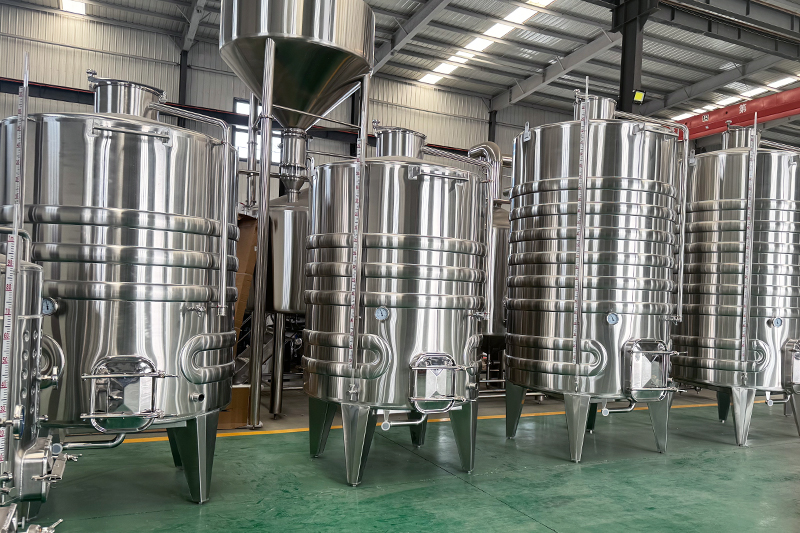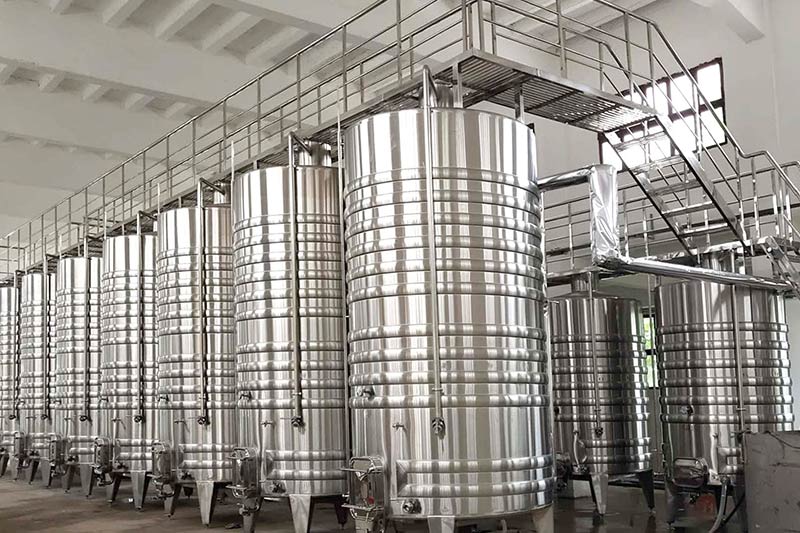Finding the Right Wine Fermenter
Are you struggling to pick the best wine fermenter for your needs? Many wineries face big issues with wrong fermenters. Bad picks can hurt wine taste, waste money, and cause spoiled batches. With so many types to pick from – stainless steel, oak, concrete, and plastic – how do you know which is best?
The Pain Gets Worse
Think about what happens with the wrong fermenter. Your wine might taste bad. You might waste thousands of dollars. The wrong tank can make your wine too hot or too cold. It might let in too much air or not enough. And cleaning problems can ruin whole batches! The fermenter choice you make now will affect your wine for years.
Micet Wine Fermenters
Micet has the answer to your wine fermenter needs. With over 15 years making top brewery equipment, we have helped set up more than 1000 breweries and wineries in 86 countries. Our wine fermenter line has options for all sizes and types of wine making. Let us help you pick the right one!
What Are Wine Fermenters?
Wine fermenters are big tanks where grape juice turns into wine. Yeast eats the sugar and makes alcohol. The fermenter keeps the wine safe while this happens.
Good fermenters must:
- Keep the right heat
- Keep bad bugs out
- Let winemakers check the wine
- Help with stirring and mixing
- Last a long time

Types of Wine Fermenters
Stainless Steel Fermenters
Stainless steel tanks are most popular. They make up 65% of the market share in 2024. These tanks have many good points:
- They are very clean
- They can last 30+ years
- They keep heat steady
- They don’t add any odd tastes
- They let you see inside with tools
The Jordan Winery case shows that stainless steel tanks with cooling can keep heat changes to just ±0.5°C. This helped them get 15% more wine from the same grapes.
Our 500L Brewery Equipment line has some of the best stainless steel tanks you can buy.
Oak Barrel Fermenters
Oak adds rich tastes to wine. The Domaine Leflaive case shows that wines made in oak barrels sold for 18% more money at auctions.
Oak barrel good points:
- Add vanilla and spice tastes
- Have a classic look
- Give wine more depth
Oak barrel bad points:
- Only last 5-7 years
- Cost more to keep clean
- Harder to check the wine

Concrete Egg Fermenters
Concrete eggs are the new trend. A study shows 32% of small US wineries now use them (up from 18% in 2019).
Concrete good points:
- Let in tiny bits of air (good for taste)
- Keep heat very steady
- Make wine have better “feel” in mouth
The Château Montelena case shows that concrete eggs helped the second part of wine making happen 22% faster. The wine also had a better feel in the mouth.
Plastic/Flexible Fermenters
Plastic tanks cost less to start. But be careful! A study shows that dirty plastic tanks have a 27% chance of bad bugs, while stainless steel only has an 8% risk.
Plastic good points:
- Low cost to buy
- Light weight
- Easy to move
Plastic bad points:
- Don’t last as long
- Can let air in when you don’t want it
- Harder to clean well
How to Choose the Right Wine Fermenter
Key Factors
1. Batch Size
How much wine will you make? This is the first big question. Micet makes wine fermenters for any size, from small home batches to big business needs.
- Small makers: Try our 200L Brewery Equipment
- Mid-size: Check out 500L to 2000L tanks
- Big makers: Our big tanks can hold 5000L or more
2. Material Impact on Wine Style
The tank type changes how your wine tastes:
| Wine Type | Best Fermenter | Why |
|---|---|---|
| Bold Reds | Oak or Concrete | Adds depth, helps tannins |
| Crisp Whites | Stainless Steel | Keeps fresh fruit taste |
| Complex Whites | Concrete Eggs | Adds rich mouth feel |
| Fast-to-Market Wine | Stainless Steel | Quick, clean process |
3. Temperature Control Needs
Heat control is key for good wine. UC Davis found that stainless steel with cooling uses 20% less power than concrete. This means:
- Lower bills
- More steady heat
- Better wine taste
- Less waste
4. Budget Considerations
Think about the long term, not just today’s cost:
- Stainless steel: More money up front, but lasts 30+ years
- Oak: Mid-cost to start, but needs new barrels every 5-7 years
- Concrete: High cost to start, but very long life
- Plastic: Low cost to start, but short life and more risk

Best Practices for Using Wine Fermenters
Fermentation Setup
Start clean for good wine. Use these steps:
- Wash all parts with no-rinse cleaner
- Rinse with clean water
- Check all seals and gaskets
- Test all valves and taps
- Cool the tank before adding juice
Pro tip: New CIP (Clean-in-Place) systems use 40% less water than hand cleaning.
During Fermentation
Check your wine every day. Look for:
- Bubbles – shows yeast is working
- Heat – keep reds at 20-30°C, whites at 10-18°C
- Cap on red wines – push down twice a day
- Smells – bad smells need quick action
Real fact: 42% of EU wineries now use smart tools to check wine heat and other things.
Post-Fermentation
When the wine is done, you must:
- Rack the wine (move it off solids)
- Clean the tank right away
- Check for any damage
- Store the tank clean and dry
Common Mistakes to Avoid
Don’t make these big errors:
- Skipping cleaning steps – Just one dirty spot can ruin wine
- Not checking heat – Too hot kills yeast; too cold stops it
- Wrong tank size – Too big means too much air
- Poor seals – Air leaks make bad wine
- Waiting to clean – Hard dried wine is very hard to clean
Advanced Techniques & Innovations
The wine world keeps changing. New methods include:
- Clay fermenters – Growing 8% each year for mineral notes
- Smart sensors – Check wine 24/7 without opening tanks
- Special shapes – New tank designs help mix wine better
- CO₂ capture – New tanks can catch this gas for other uses
Top Wine Fermenter Brands
Premium Tier
- Bucher Vaslin – Best for big wineries
- Nomblot – Known for egg-shaped concrete
- Micet – Custom solutions for any winery size
Budget Tier
- The Vintner’s Vault
- Fermentis
- Micet Economy Line – Quality at lower cost
Why Choose Micet for Your Wine Fermenters?
Micet solves all your wine making equipment needs. Here’s why we stand out:
- 15+ years making top wine and beer equipment
- 12 service centers around the world (France, Australia, Canada, and more)
- 3-year warranty on all tanks (most brands only give 1 year)
- Custom designs made just for your needs
- Full support from first call to years after sale
Our team, led by CEO Nancy with 15 years of sales know-how, works hard to make sure you get the right tools. Our quality team has 11 years checking every tank. Our service team has 22 years of know-how.
We’ve helped set up over 1000 breweries and wineries in 86 countries. Our clients say our tanks beat all others for quality and life span.
FAQs About Wine Fermenters
Can I reuse wine fermenters for different batches?
Yes! With good cleaning, you can use the same tank for many years and many kinds of wine.
Stainless steel vs. oak: Which is better for red wine?
Both work well. Stainless gives clean fruit taste. Oak adds depth and spice notes. Many wineries use both.
How to clean fermenters?
Use no-rinse cleaners made for wine. CIP systems work best for big tanks. Small tanks can be hand-cleaned.
How long do wine fermenters last?
- Stainless steel: 30+ years
- Concrete: 20+ years
- Oak: 5-7 years
- Plastic: 3-5 years
Can Micet design custom fermenters?
Yes! We love making custom tanks. Tell us what you need, and we’ll build it.
Ready to Find Your Perfect Wine Fermenter?
Don’t let the wrong fermenter hurt your wine. Micet has the right tank for you, no matter your size or style.
Contact us today to:
- Get a free quote
- Talk to our wine tank experts
- See our full line of wine making tools
- Learn about our 3-year warranty
Your great wine starts with the right fermenter. Let Micet help.
Click here to see our Wine Fermenter line and start making better wine today!
Wine Fermenters: Key Insights
Stainless Steel
65% market share
30+ year lifespan
Oak Barrels
18% higher prices
5-7 year lifespan
